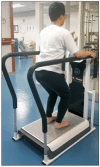Effect of Whole Body Horizontal Vibration Exercise in Chronic Low Back Pain Patients: Vertical Versus Horizontal Vibration Exercise
- PMID: 30613073
- PMCID: PMC6325321
- DOI: 10.5535/arm.2018.42.6.804
Effect of Whole Body Horizontal Vibration Exercise in Chronic Low Back Pain Patients: Vertical Versus Horizontal Vibration Exercise
Abstract
Objective: To elucidate the effect of a 12-week horizontal vibration exercise (HVE) in chronic low back pain (CLBP) patients as compared to vertical vibration exercise (VVE).
Methods: Twenty-eight CLBP patients were randomly assigned to either the HVE or VVE group. All participants performed the exercise for 30 minutes each day, three times a week, for a total of 12 weeks. Altered pain and functional ability were evaluated using the visual analog scale (VAS) and Oswestry Disability Index (ODI), respectively. Changes in lumbar muscle strength, transverse abdominis (TrA) and multifidus muscle thicknesses, and standing balance were measured using an isokinetic dynamometer, ultrasonography, and balance parameters, respectively. These assessments were evaluated prior to treatment, 6 weeks and 12 weeks after the first treatment, and 4 weeks after the end of treatment (that is, 16 weeks after the first treatment).
Results: According to the repeated-measures analysis of variance, there were significant improvements with time on VAS, ODI, standing balance score, lumbar flexor, and extensor muscle strength (all p<0.001 in both groups) without any significant changes in TrA (p=0.153 in HVE, p=0.561 in VVE group) or multifidus (p=0.737 in HVE, p=0.380 in VVE group) muscle thickness. Further, there were no significant differences between groups according to time in any of the assessments. No adverse events were noticed during treatment in either group.
Conclusion: HVE is as effective as VVE in reducing pain, strengthening the lumbar muscle, and improving the balance and functional abilities of CLBP patients. Vibrational exercise increases muscle strength without inducing muscle hypertrophy.
Keywords: Balance; Low back pain; Muscle strength; Vibration; Visual analog scale.
Conflict of interest statement
No potential conflict of interest relevant to this article was reported.
Figures


References
-
- Krismer M, van Tulder M, Low Back Pain Group of the Bone and Joint Health Strategies for Europe Project Strategies for prevention and management of musculoskeletal conditions. Low back pain (non-specific) Best Pract Res Clin Rheumatol. 2007;21:77–91. - PubMed
-
- Trapp W, Weinberger M, Erk S, Fuchs B, Mueller M, Gallhofer B, et al. A brief intervention utilising visual feedback reduces pain and enhances tactile acuity in CLBP patients. J Back Musculoskelet Rehabil. 2015;28:651–60. - PubMed
-
- Bagheri R, Takamjani IE, Dadgoo M, Sarrafzadeh J, Ahmadi A, Pourahmadi MR, et al. A protocol for clinical trial study of the effect of core stabilization exercises on spine kinematics during gait with and without load in patients with non-specific chronic low back pain. Chiropr Man Therap. 2017;25:31. - PMC - PubMed
-
- Graves JE, Pollock ML, Foster D, Leggett SH, Carpenter DM, Vuoso R, et al. Effect of training frequency and specificity on isometric lumbar extension strength. Spine (Phila Pa 1976) 1990;15:504–9. - PubMed
-
- Gill KP, Callaghan MJ. The measurement of lumbar proprioception in individuals with and without low back pain. Spine (Phila Pa 1976) 1998;23:371–7. - PubMed
LinkOut - more resources
Full Text Sources

